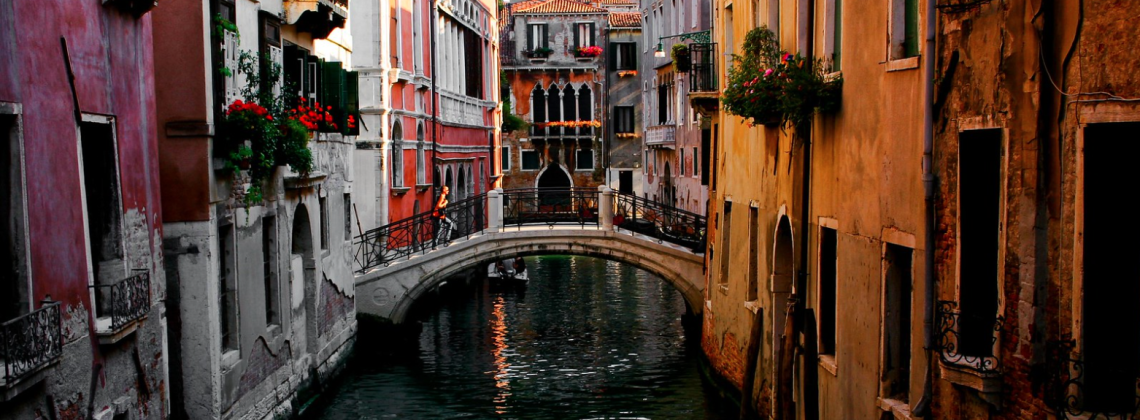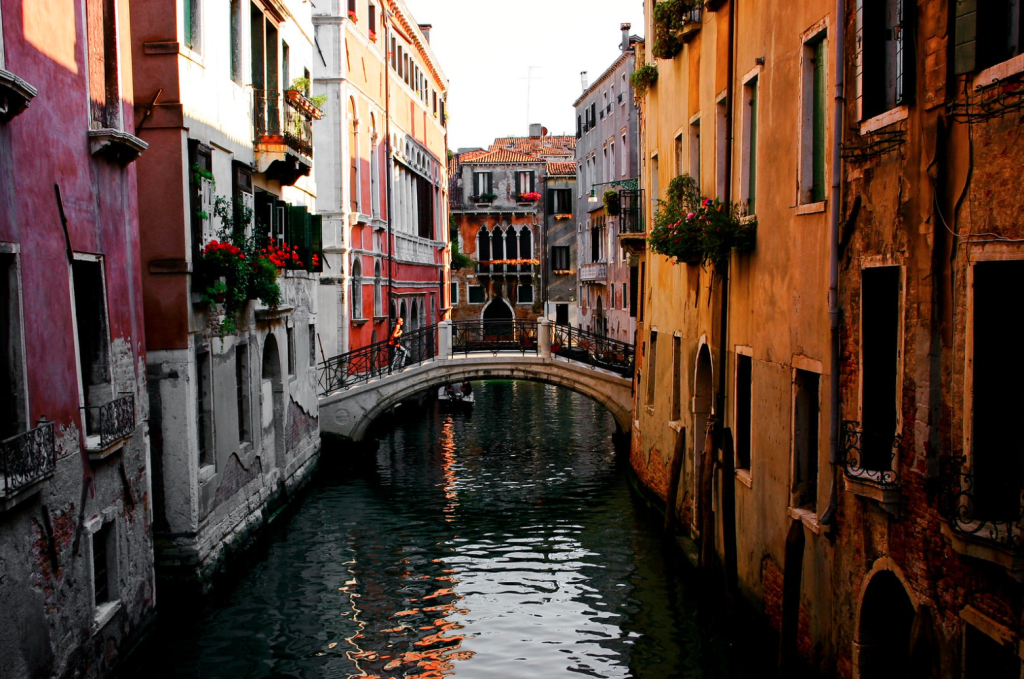

If we have the choice, why not make things beautiful?
With this essay we continue our summer series “Oh The Places We Went.” It may be the last vestige of childhood in the souls of grown-ups, but summer somehow feels different from the rest of the year. Summer may involve travel or it may mostly just involve a different schedule at home, especially for those of us with kids or who work in the education sector. In this series, we collect stories and reflections that consider these summertime adventures in all their complexity and simplicity.
*
I spent May in Italy—or, rather, Italia. The group I was traveling with began and ended our journey in Rome, with a trip to Florence and Venice in the middle.
Prior to this adventure I had never set foot in Europe. But as a college senior pursuing a Bachelor of Fine Arts, I felt like I knew what to expect. So much of our art-historical canon can be traced to the Italian peninsula. As someone who is being trained to engage with and contribute to the discourse of the art world, I had a greater awareness than some of my peers as to what we would be seeing. I am not claiming to be an art historian, but I can tell a Bernini from a Michelangelo, a Botticelli from a Raphael. While almost everyone knows a great piece of art when they see it, I had the advantage of knowing what made it great, and why it has remained relevant across history.
Because of this I was generally not surprised when I turned the corner in the Uffizi Gallery and suddenly found myself face to face with Botticelli’s Birth of Venus. I was not shocked to see Bernini’s Rape of Proserpina. (Although, don’t be mistaken, I was blown away all the same.) I knew what to expect, and for the most part I saw what I was expecting—and it was marvelous.
However, there was something deeper to this experience that I was not expecting and perhaps could never have expected: the Italian awareness of the aesthetic, which transcends the gallery.
“Aesthetic” has come to be something of a classier synonym for “artsy”: That coffee shop was just sooo aesthetic, as my Gen Z peers might say. However, in the way I am using the term it does not describe a singular event, object, or place but rather an omnipresent dimension of creation. It is not a kind of experience; it is a mode of experience.
Often we are more aware of the aesthetic mode of experience than we may think. For example, my family often goes on a walk in the neighborhood or in the park on a Sunday evening because we crave (though we never say it) a different, more enriching aesthetic (fresh air, the sounds of birds, the final rays of the sun stretching shadows across the pavement) than the one that we find inside of our home. Sometimes when I am at school in Chicagoland I will choose to drive my car to a function rather than take public transportation because I feel that the aesthetic of public transportation (foul smells, dirtiness, loud noises, lack of personal space) is worth avoiding, even if the train or bus may be cheaper and more efficient than driving. These are not decisions based solely on aesthetics. And someone could take a walk for the exercise or choose to drive themselves to a place because they do not want to be at the mercy of delays on a train or bus system. However, it cannot be denied that we do enter the aesthetic mode when making these choices, as we do constantly throughout our days.
What I experienced in Italy, and that I could never have really been prepared for with any amount of art-historical knowledge, was the deeply enriching effect that comes from a society that has made a commitment to live life aesthetically aware. I felt a dedication to beauty that goes beyond the marble and canvas and spills onto the street. When we Americans encounter something inefficient, we get upset. But if you think of how Americans value efficiency and substitute that with aesthetics, you begin to get the sense of what I experienced in Italy.
Perhaps no place better exemplifies this than the Canal City, Venice. In its very nature Venice is wildly impractical for life in the twenty-first century. There are no cars on its major island, and only four bridges that can take one across the grand canal as it snakes through the center of the island. While the city is quite small, the lack of direct walking paths, or any street pattern for that matter, can make it difficult to traverse. I found myself utterly lost more than once. As for public transportation, if you truly understand the vaporetto (waterbus) system, you deserve a medal. None of this makes for a practical or efficient experience when navigating, and trips your GPS says will only take twenty minutes might end up taking more than an hour (spoken from experience). Yet I never once felt that anything was wrong with the place. This was because its aesthetics made it simply a joy to be, to exist, within. It did not matter that I did not always know where I was going, because it was such a joy being anywhere.
The city understands that its rich harnessing of the aesthetic is its heartbeat. One example of this commitment to a unified aesthetic can be seen in perhaps one of its most iconic features: the gondola. Each gondola must adhere to strict rules of design. Every gondola—which must be painted black—is loaded with symbolism. The prow of each has a metal dolfin, which artfully references the six districts of the city, the iconic Rialto bridge, the four major islands, and the Doge’s cap, while also serving as a counterweight to the gondolier—a distinctive piece of design, fascinating to look at. This is one acute example of aesthetic commitment. A broader example of the aesthetic consciousness in Venice is the uniqueness of its architecture. Being the traditional gateway to the East for hundreds of years, it features a melding of traditionally Western and Eastern motifs. While it’s very impressive formally, what I was most struck by is the manner of preservation. I got the sense that this form is being preserved not just because it is historic but because its aesthetic quality is irreplicable.
To some extent, the same could be said about every city I visited. Whether it be the way you see ancient and modern forms intertwined in the cobbled streets of Rome, or in the sheer perfection of Florence, it was obvious that Italians understand that a person’s experience of the aesthetic should never end when they step out of a museum or gallery. If we have the choice, why not make things beautiful?
Christopher Miller is a senior at Trinity Christian College (Palos Heights, IL) where he is studying to receive the Bachelor of Fine Arts with a minor in philosophy. You can see his sketchbook, watercolor studies, and photos from Italy, as well as other work, on Instagram at @c.miller_paint.
Image: A Strakey, Homes in Venice
I had similar experiences this summer as I got to visit port cities (via cruise ship) in eastern Spain, Morocco, the Balearics, the Côte d’Azur, Malta, Sicily, Lipari, Amalfi, and finally Rome. Three weeks in midsummer, and every day was “the same”: something interesting and, usually, lovely to set one’s eyes upon everywhere one looked. Even staircases and steps were designed with care and led up and down to arresting sights. Look up a street as one walks along and so very often see something truly remarkable. Details on every building, every house. Centuries of caring about life lived here, in this village or this town or this city.
And the tastes and smells! Markets in the smallest of villages overflowing with cheeses and sausages and lovingly raised vegetables and fresh fish and jars of piquancy. Amid the tourist crap manufactured in east Asia there could be found local goods: striking carvings, clever jewelry, careful woodwork, surprising dolls, and joyful fabrics. (I got to Cassis again and went to one of my favourite stores for shirts, ties, and pocket squares, Souleiado, specializing in Provençal patterns. Impossible to be in a bad mood wearing their stuff.)
I can’t afford to cruise on a professor’s salary, so I lecture on board to pay my way. And as I introduced my audience to the architecture of Gaudí on our way into Barcelona, I rejoiced to explain why this Christian artist put a snail and a dog on his glorious church, and did so so beautifully. Our marvelous Creator loves all, and loves details.
So may we find ways to live lives that are not just true and good, but also beautiful. The Bible doesn’t focus much on the aesthetic, to be sure. But it recognizes, often, that God delights in creativity and expects his creature-created-in-his-image-to-be-creative to delight in creativity also.
Let’s learn and tell the truth, and let’s learn and practice the good. But our homes, our bodies, and our speech: These are our little domains in which to promote and produce shalom, to flourish, and as much as we can. As my friend Mako Fujimura likes to ask, “What did you make today?”
I hope it was something beautiful—for God.